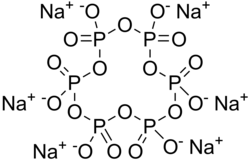Sodium hexametaphosphate
Chemical compound From Wikipedia, the free encyclopedia
Sodium hexametaphosphate (SHMP) is a salt of composition Na6[(PO3)6].[3] Sodium hexametaphosphate of commerce is typically a mixture of metaphosphates (empirical formula: NaPO3), of which the hexamer is one, and is usually the compound referred to by this name. Such a mixture is more correctly termed sodium polymetaphosphate. They are white solids that dissolve in water.
 | |
 | |
 | |
| Names | |
|---|---|
| IUPAC name
sodium cyclo-hexaphosphate | |
| Other names
Calgon S Glassy sodium | |
| Identifiers | |
3D model (JSmol) |
|
| ChemSpider | |
| ECHA InfoCard | 100.030.299 |
| EC Number |
|
| MeSH | sodium+polymetaphosphate |
PubChem CID |
|
| UNII | |
CompTox Dashboard (EPA) |
|
| |
| |
| Properties | |
| Na6[(PO3)6] | |
| Molar mass | 611.7704 g mol−1 |
| Appearance | White crystals |
| Odor | odorless |
| Density | 2.484 g/cm3 |
| Melting point | 628 °C (1,162 °F; 901 K) |
| Boiling point | 1,500 °C (2,730 °F; 1,770 K) |
| soluble | |
| Solubility | insoluble in organic solvents |
Refractive index (nD) |
1.482 |
| Hazards | |
| Occupational safety and health (OHS/OSH): | |
Main hazards |
Irritant |
| GHS labelling:[2] | |
 | |
| Warning | |
| H319 | |
| Lethal dose or concentration (LD, LC): | |
LD50 (median dose) |
3.053 g kg−1 |
| Safety data sheet (SDS) | hazard.com |
| Related compounds | |
Other anions |
Trisodium phosphate Tetrasodium pyrophosphate Pentasodium triphosphate |
Related compounds |
Sodium trimetaphosphate |
Except where otherwise noted, data are given for materials in their standard state (at 25 °C [77 °F], 100 kPa).
| |
Uses
Summarize
Perspective
SHMP is used as a sequestrant and has applications within a wide variety of industries, including as a food additive in which it is used under the E number E452i. Sodium carbonate is sometimes added to SHMP to raise the pH to 8.0–8.6, which produces a number of SHMP products used for water softening and detergents.
A significant use for sodium hexametaphosphate is as a deflocculant in the production of clay-based ceramic particles.[4][5][6][7] It is also used as a dispersing agent to break down clay and other soil types for soil texture assessment.[8]
It is used as an active ingredient in toothpastes as an anti-staining and tartar prevention ingredient.[9]
Food additive
As a food additive, SHMP is used as an emulsifier. Artificial maple syrup, canned milk, cheese powders and dips, imitation cheese, whipped topping, packaged egg whites, roast beef, fish fillets, fruit jelly, frozen desserts, salad dressing, herring, breakfast cereal, ice cream, beer, and bottled drinks, among other foods, can contain SHMP.[10][11][12]
Water softener salt
SHMP is used in Diamond Crystal brand Bright & Soft Salt Pellets for water softeners in a concentration of 0.03%. It is the only additive other than sodium chloride.
Preparation
SHMP is prepared by heating monosodium orthophosphate to generate sodium acid pyrophosphate:
- 2 NaH2PO4 → Na2H2P2O7 + H2O
Subsequently, the pyrophosphate is heated to give the corresponding sodium hexametaphosphate:
- 3 Na2H2P2O7 → (NaPO3)6 + 3 H2O
followed by rapid cooling.
Reactions
SHMP hydrolyzes in aqueous solution, particularly under acidic conditions and/or heat, to sodium trimetaphosphate and sodium orthophosphate.[13]
History
Summarize
Perspective
Sodium hexametaphosphate is the alkali salt of one of the series of polymetaphosphoric acids (acids formed by the polymerization of phosphate groups).[14] Hexametaphosphoric acid was first made in 1825 by the German chemist Johann Frederich Philipp Engelhart (1797-1853).[15] For his doctoral thesis, Engelhart intended to determine whether iron was responsible for the red color of blood. In order to purify his blood samples, Engelhart had found that he could coagulate the blood serum's albumin (dissolved proteins) by treating the blood with phosphoric acid. This contradicted the findings of the famous Swedish chemist Jöns Jacob Berzelius, who had stated that phosphoric acid did not coagulate water-soluble proteins such as egg white.[16] Berzelius and Engelhart collaborated with the intention of resolving the contradiction; they concluded that Engelhart had produced a new form of phosphoric acid simply by burning phosphorus in air and then dissolving the resulting substance in water.[17] However they did not determine the new acid's composition. That analysis was accomplished in 1833 by the Scottish chemist Thomas Graham, who named the sodium salt of the new acid "metaphosphate of soda".[18] Graham's findings were confirmed by the German chemists Justus von Liebig and Theodor Fleitmann.[19] In 1849 Fleitmann coined the name "hexametaphosphoric acid".[20][21]
By 1956, chromatographic analysis of hydrolysates of Graham's salt (sodium polyphosphate) indicated the presence of cyclic anions containing more than four phosphate groups;[22] these findings were confirmed in 1961.[23] In 1963, the German chemists Erich Thilo and Ulrich Schülke succeeded in preparing sodium hexametaphosphate by heating anhydrous sodium trimetaphosphate.[24]
Safety
Sodium phosphates are recognized to have low acute oral toxicity. SHMP concentrations not exceeding 10,000 mg/L or mg/kg are considered protective levels by the EFSA and US FDA. Extreme concentrations of this salt may cause acute side effects from excessive blood serum concentrations of sodium, such as: “irregular pulse, bradycardia, and hypocalcemia."[25]
References
External links
Wikiwand - on
Seamless Wikipedia browsing. On steroids.
